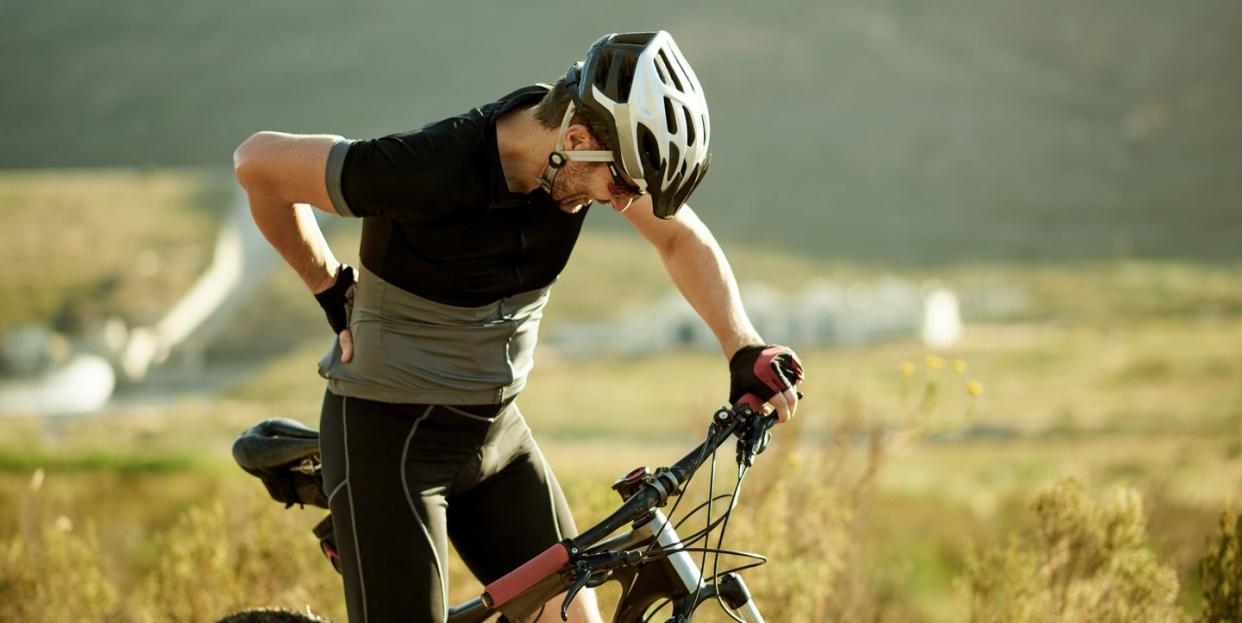If You Experience Low Back Pain, You Should Probably Check Your Daily Posture

Sitting or standing for long periods of time might cause you to arch your low back which can contribute to back pain—aches that plague plenty of cyclists and that many of us struggle to find ways to address.
This excessive arching of the low back is called swayback posture and it’s worth paying attention to, in order to avoid aches. Here, experts explain what swayback posture is, how it can contribute to low back pain, and what exercises will help you combat it.
What is swayback posture?
Naturally, we all have an S-shaped curve in our spine to help us dissipate forces as we move, walk, and complete activities like cycling, says Joel Press, M.D., physiatrist-in-chief at the Hospital for Special Surgery in New York City and professor of rehabilitation medicine at Weill Cornell Medical College. But swayback posture, which some experts refer to as lordosis, implies an increased arch in the low back, which can sometimes up your risk of low back pain, Press says.
While having a bit of an arch in the low back is normal (and typically comfortable for most people), swayback means the bottom of the S curve gets emphasized to an extreme degree.
In addition to that curve of the low spine, swayback posture can also lead to a compensatory rounding of the upper spine and a forward head posture, according to Marilyn Moffat, Ph.D., D.P.T., professor of physical therapy at New York University.
What causes swayback posture?
There are many different factors that can lead to swayback posture. For example, wearing high heels, pregnancy, and sports like gymnastics, says Moffat. But another common factor among cyclists with this posture: muscle imbalances.
“With swayback muscle posture, most people tend to have weaker abdominals and they’ll tend to have weaker muscles on the back of their legs in their posterior chain,” says Paul Coviello, P.T., D.P.T., O.C.S., board-certified clinical specialist in orthopedic physical therapy and owner of Summit Physical Therapy in New Jersey. Cycling can contribute to that because on the bike, our arms tend to support our upper body rather than posture-supporting muscles (like the spine extensors known as the erector spinae). Plus, long-distance cycling doesn’t always promote a strong posterior chain, he explains.
Not to mention, sitting for long periods of time can contribute to tight hip flexors, which make it harder to stand upright without arching your back, says Press. As a cyclist, when you’re hunched over in a racing position on a bike for a long ride, it can be even worse than sitting in a chair for hours, he adds.
3 Ways to Combat Swayback Posture
A few daily practices will help you address this misalignment and relieve your achy back:
1. Practice Better Alignment
Moffat suggests starting by familiarizing yourself with good postural alignment and practicing it throughout the day. A good way to visualize proper posture is to imagine your skeleton at a side view. You should be able to draw a line running through one side of your body. The line should intersect at your earlobe, fall through your shoulder joint and hip joint, then pass through the midline of the knee, and finally end at the center of the ankle joint, she explains.
2. Adjust Your Workstation
If you work at a desk, make sure you’re positioned correctly. This means appropriately positioning the chair so when you’re at your computer, you’re not looking up at your monitor, as this will strain your neck, says Moffat.
Instead, position the monitor so you’re looking straight ahead, chin slightly back and in, while you’re sitting in a supportive chair, she explains. Shoulders should also sit right on top of hips.
3. Dedicate Time to Strength Work
Core exercises can do more than just boost your performance. Moffat suggests practicing plank variations and bird dogs with proper postural alignment (that means a neutral spine, with shoulders and hips in one straight line—no arching the low back) to reinforce good posture.
Coviello agrees that core work is essential for everyone, including cyclists, and suggest adding dead bugs to your routine, as it not only helps you strengthen the midsection muscles, but does so while you maintain a straight spine with your back against the floor.
Also, consider practicing a lying hamstring stretch with a resistance band looped around one foot, opposite leg bent with foot planted. Straighten the leg with the resistance band toward the ceiling. Hold for about 30 to 60 seconds. Moffat suggests this variation of a hamstring stretch because it allows you to easily stabilize the back against the floor.
Finally, Coviello suggests adding deadlifts to your strength workouts. This crucial move targets your abdominals, helps you maintain a neutral pelvic position, and that can help you keep a flat back on the bike. Plus, it targets the posterior chain—an important part of maintaining strong body alignment.
You Might Also Like

